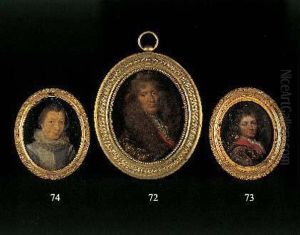Roger De Piles Paintings
Roger de Piles was a distinguished French art critic, painter, and diplomat, born in Clamecy, France, in 1635. Throughout his life, de Piles played a significant role in the European art scene of the 17th century, not only through his artistic endeavors but also through his critical writings and diplomatic service. His contributions to art theory and criticism are particularly notable for their impact on the development of aesthetic thought in Europe.
De Piles's career was marked by a profound engagement with the art and artists of his time. He traveled extensively across Europe, which allowed him to study a wide range of artworks first-hand. This experience was crucial in shaping his approach to art criticism. De Piles was known for his advocacy of color over design, aligning him more closely with the Rubenist side in the Poussinist-Rubenist debate, which centered around whether drawing or color was more important in painting. His writings provided a counterpoint to the dominant classicist aesthetic of his time, championing the Baroque style's dynamic and expressive qualities.
One of his most influential works is 'Cours de peinture par principes' published in 1708, a year before his death. In this book, de Piles outlined his theories on painting, emphasizing the importance of emotional engagement and the expressive power of colors. He also compiled the 'Balance des peintres', a ranking of artists based on their merits in composition, drawing, color, and expression, which has been influential in the historiography of art.
Throughout his career, Roger de Piles also engaged in diplomatic service, which took him to various European courts. His diplomatic work often intersected with his interest in art, as he used his missions to collect artworks and to meet with prominent artists of his time. Despite his involvement in politics, de Piles remained deeply committed to the study and promotion of art, contributing significantly to the appreciation and understanding of 17th-century European painting.
Roger de Piles passed away in 1709, leaving behind a legacy that has continued to influence art criticism and theory. His works remain a vital source for understanding the art and aesthetics of the Baroque period, reflecting a nuanced appreciation of the interplay between color, emotion, and expression in painting.


